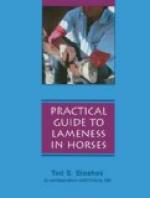Whether spavin has its point of origin within the articulation as a rarefying ostitis of the cancellated structure of the lower tarsal bones as suggested by Eberlein; or, as Diekerhoff asserts, that the cunean bursa may be the initial point of affection, is unsettled; but it is reasonable to consider occult spavin as having its origin within the articulation, and that cases readily yielding to cunean tenotomy are primarily due to affection of the cunean bursa.
Symptomatology.—Where a visible exostosis exists, the presence of spavin is easily detected, yet exostoses that extend over large areas may constitute cause for serious trouble and still be difficult of detection. By observing the internal surface of the hock from various suitable angles, such as from between the forelegs or directly behind the subject, one may note the presence of any ordinary exostosis.
The position assumed by the spavined horse is often characteristic. More or less knuckling is usually present (Liautard, McDonald). There is abduction of the stifle in some cases, or the toe may be worn in unshod horses so that it presents a straight line at the surface. This is manifested to a great degree in some animals and in others the foot is not dragged and there is no wearing of the hoof at the toe.
Spavin lameness is so distinctive that one trained and experienced in the examination of horses that are spavined, should correctly diagnose the condition in practically every instance without recourse to other means than noting the peculiar character of the gait of the subject. Lameness develops gradually in the majority of instances, and an important feature in spavin lameness is that it disappears after the subject has gone a little way, to return again as soon as the animal has rested for a variable length of time—from a half hour to several hours. This “warming out” is marked during the incipient stage, but less pronounced in most chronic cases. A complete disappearance of lameness is observed in some instances, while in others only partial subsidence is evident. Because of the fact that pain is occasioned both during weight bearing and while the leg is being flexed and advanced, there is manifested the characteristic mixed lameness and exaggerated hip action which typifies spavin. By throwing the hips upward with the sound member it is possible to advance the affected leg with less flexion, hence less pain is experienced in this manner of locomotion. When made to step aside in the stall, a spavined horse will flex the affected member abruptly and when weight is taken on the diseased leg, symptoms are evinced of pain, and weight is immediately shifted to the sound limb. This is marked during the incipient stages of spavin. Lameness usually precedes the formation of exostosis, though cases are observed wherein an exostosis is present and no lameness is manifested and no history of the previous existence of lameness is available.




